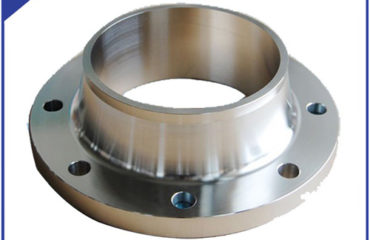(1) The data of low hardness and good toughness of stainless steel flange, such as low carbon steel and aluminium alloy, have low hardness and good toughness. It is difficult to break chips during cutting, and it is easy to produce chip accumulating tumors, which affects the surface quality of processing. Therefore, large rake angle, high speed cutting or large rake angle, low speed cutting and cutting fluid are often used to process stainless steel flange data. It can grind the chip breaking groove on the cutting tool and improve the grinding quality of cutting edge and knife face. In addition, for low carbon steel, normalizing is stopped to refine grains; for aluminium alloy, cold deformation is used to improve the hardness of data and the machinability of such data.
(2) The data of high hardness and poor toughness of stainless steel flange, such as high carbon steel, carbon tool steel and cast iron, are of high hardness and poor toughness. The cutting force produced during cutting is high, the power consumption is high, and the tool is easy to wear. Therefore, high wear-resistant YG, YT and YW cemented carbide blades, small rake angle and main deviation angle, and low cutting speed are often used to process this kind of data. In addition, high temperature annealing can be stopped for gray cast iron with white mouths, and annealing can be used for hard malleable cast iron, high carbon steel and carbon tool steel to reduce hardness and improve machinability.
There are many kinds and specifications of stainless steel flange. In order to distinguish, use and manage conveniently, machine tools must be classified. Stainless steel flanges are mainly classified according to their processing properties and tool stops used. At present, our country divides machine tools into 12 categories: lathe, drilling machine, boring machine, grinder, gear processing machine, thread processing machine, milling machine, cutting machine, broaching machine, ultrasound involves electrical processing machine, cutting machine and other machine tools. In addition to the above-mentioned fundamental taxonomy, there are other taxonomies. According to the level of universality, machine tools can be divided into:
(1) Universal stainless steel flange can process various parts of different processes, processing a wide range. For example, horizontal lathe, horizontal milling and boring machine, universal lifting table milling machine, etc., are all general purpose machine tools. Because of its good versatility, universal machine tools are often comparatively complicated in construction. General machine tools are mainly suitable for single-piece and small-batch consumption.
(2) Specialized machine tools, such as machine tools, are specially used to process one (or several) specific processes of one or several types of parts of different sizes. For example, precision screw lathe, camshaft lathe, crankshaft connecting rod neck lathe and so on belong to special machine tools.
(3) Special machine tools, such as special machine tools, are used to process a particular kind of (or several) parts. For example, the special boring machine for the spindle box of machine tool, the special gantry grinder for the guide rail of lathe bed and so on are all special machine tools. Special machine tools are specially designed and manufactured according to specific process requirements. Its consumption rate is comparatively high, and its automation level is often comparable. Modular machine tools are also special machine tools in essence.
 Language
Language Espanol
Espanol English
English Italian
Italian عربى
عربى
 Skype: chinamaker99
Skype: chinamaker99  Tel: 86-316-5120812
Tel: 86-316-5120812 Email:
Email:  Whatsapp:
Whatsapp: 